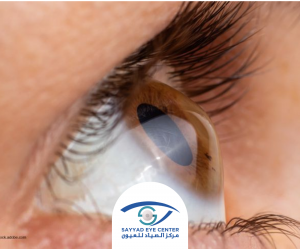 What is Keratoconus?
What is Keratoconus?
Keratoconus is a condition that affects the shape of the cornea, which is the transparent part covering the front of the eye. Normally, the cornea has a round, dome-like shape. In keratoconus, it takes on an abnormal cone-like shape, negatively impacting the quality of vision.
Causes of Keratoconus
Keratoconus can affect anyone, but it is more common in the following cases:
- Genetic factors: Having a family history of keratoconus increases the likelihood of developing the condition.
- Chronic eye allergies: Individuals who suffer from chronic eye allergies since childhood, or who frequently rub their eyes excessively, are at a higher risk.
- Age group: Keratoconus is more prevalent among young people, though it can be diagnosed at different ages, whether younger or older.
Symptoms of Keratoconus
Common symptoms of keratoconus include:
- Blurred vision that may not be fully corrected by glasses.
- Double vision or the appearance of distorted lines around light sources.
Note: A definitive diagnosis requires consulting a doctor and undergoing the necessary examinations to confirm the presence of keratoconus.
How is Keratoconus Diagnosed?
Accurate diagnosis of keratoconus involves a comprehensive eye examination using advanced devices, including:
- Slit Lamp Examination: To thoroughly evaluate the cornea.
- Corneal imaging using OCT or Tomography: Modern technologies that provide precise details about the cornea’s thickness, elevation, and shape.
Available Treatment Options
Treatment depends on the severity of the condition and its progression. The available options include:
-
Corneal Cross-Linking:
A non-surgical procedure aimed at strengthening the corneal tissue to halt the progression of keratoconus.
-
Intracorneal Rings:
These rings help improve the shape of the cornea, reduce visual distortions, and enhance vision.
-
Corneal Transplantation:
In advanced cases, corneal transplantation is the final solution to restore vision. It can involve either a full or partial transplant, depending on the specific case.
Improving Vision in Keratoconus Cases
Important Note: Traditional LASIK surgery is not suitable for keratoconus patients, as it further weakens the cornea. However, in rare cases, PRK may be performed cautiously with Crosslinking..
Other effective alternatives for vision improvement include:
- Rigid Contact Lenses: These provide significant enhancement to vision quality.
- Implantable Collamer Lenses (ICL): These lenses are implanted inside the eye, in front of the natural lens, to improve vision without affecting the cornea. They are used in stable cases.
The Importance of Early Screening
If you have a family history of keratoconus, or if your children suffer from persistent allergies and frequently rub their eyes, it is recommended to undergo regular eye check-ups. Early detection of the condition helps preserve vision and prevents complications.
In conclusion, we emphasize the importance of consulting a doctor if any symptoms appear. Stay tuned for our upcoming articles, where we’ll delve deeper into treatment methods and how to improve the quality of life for keratoconus patients.

